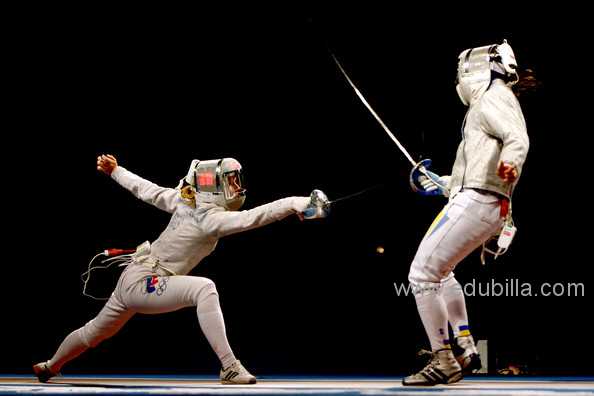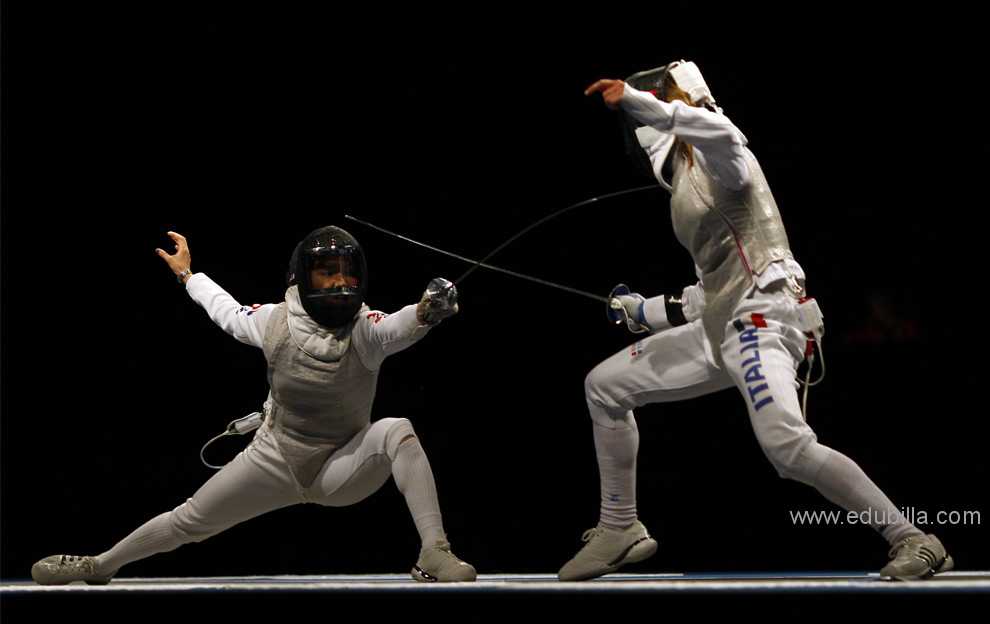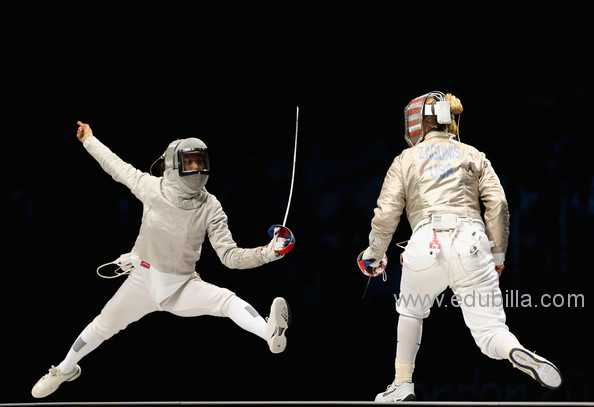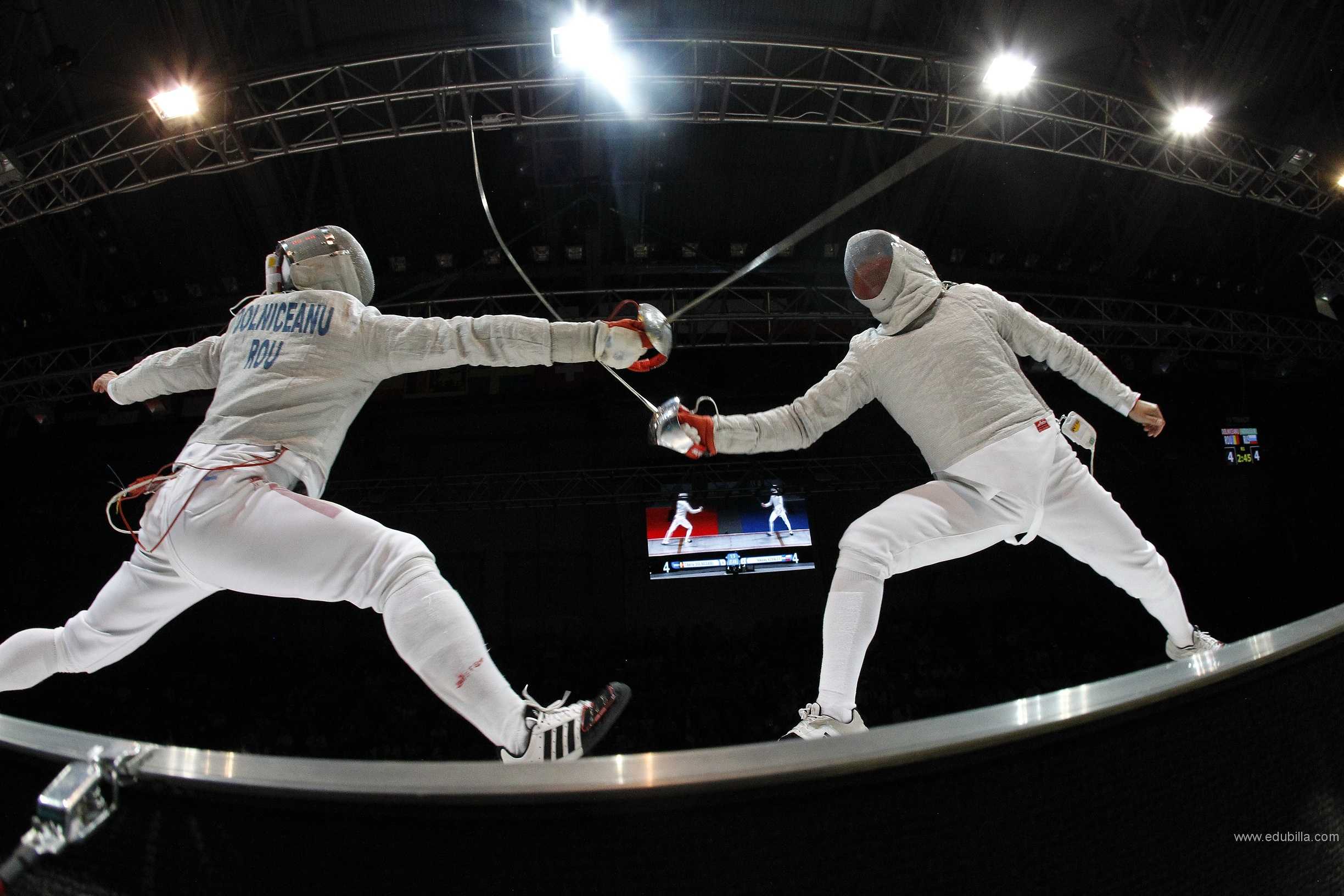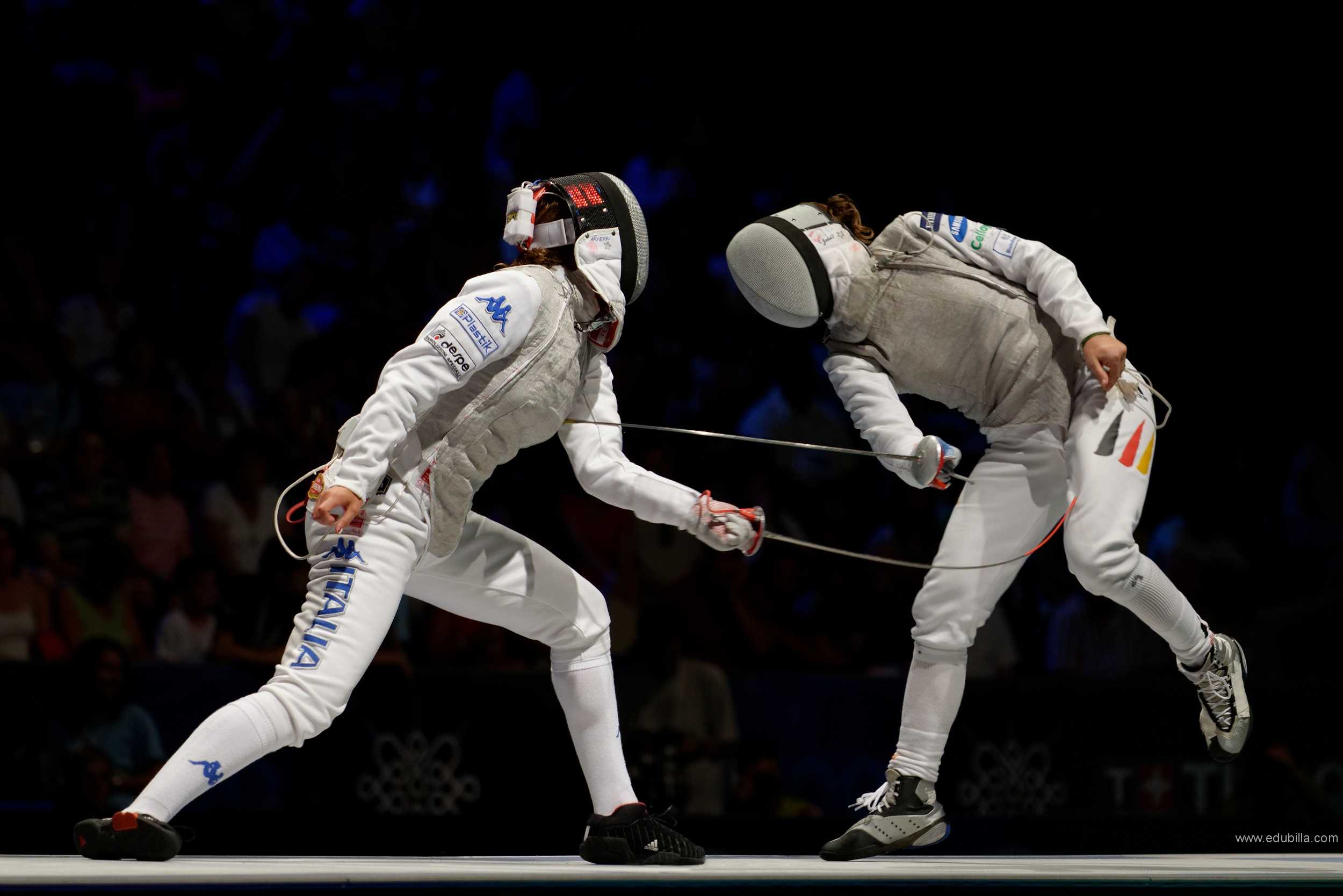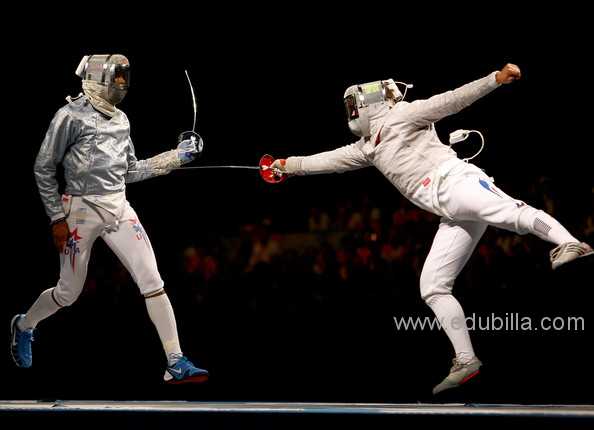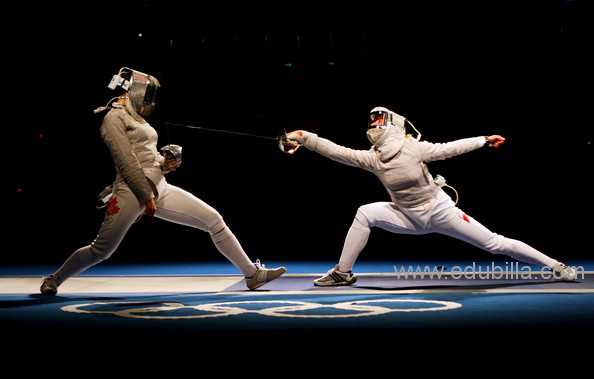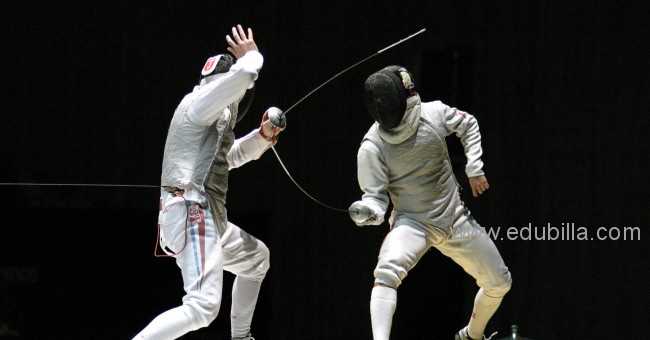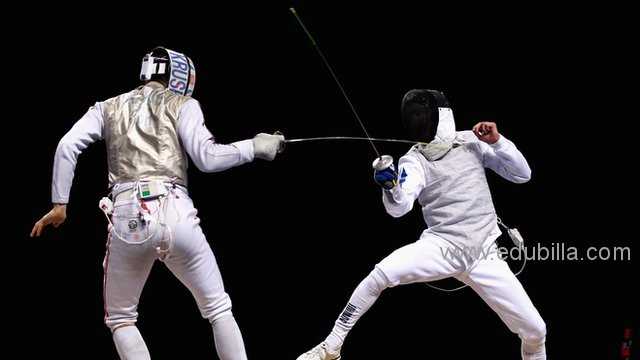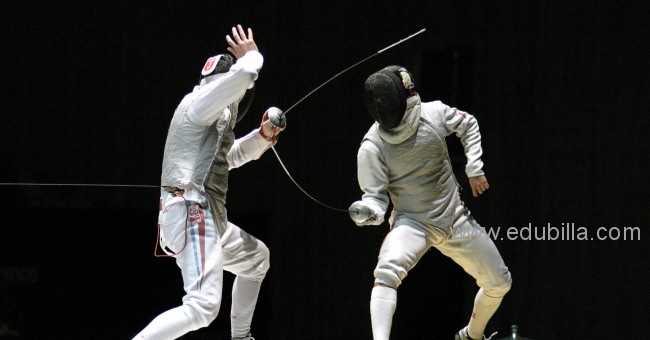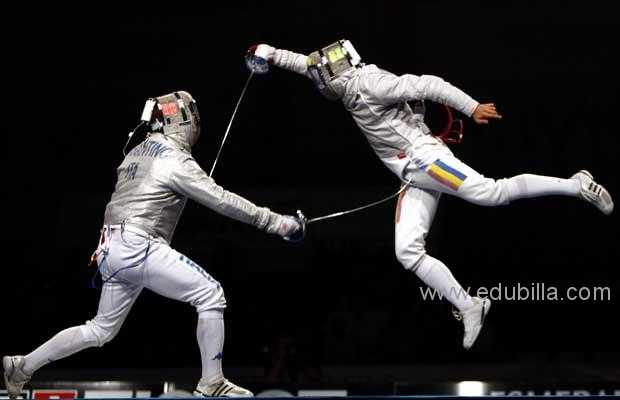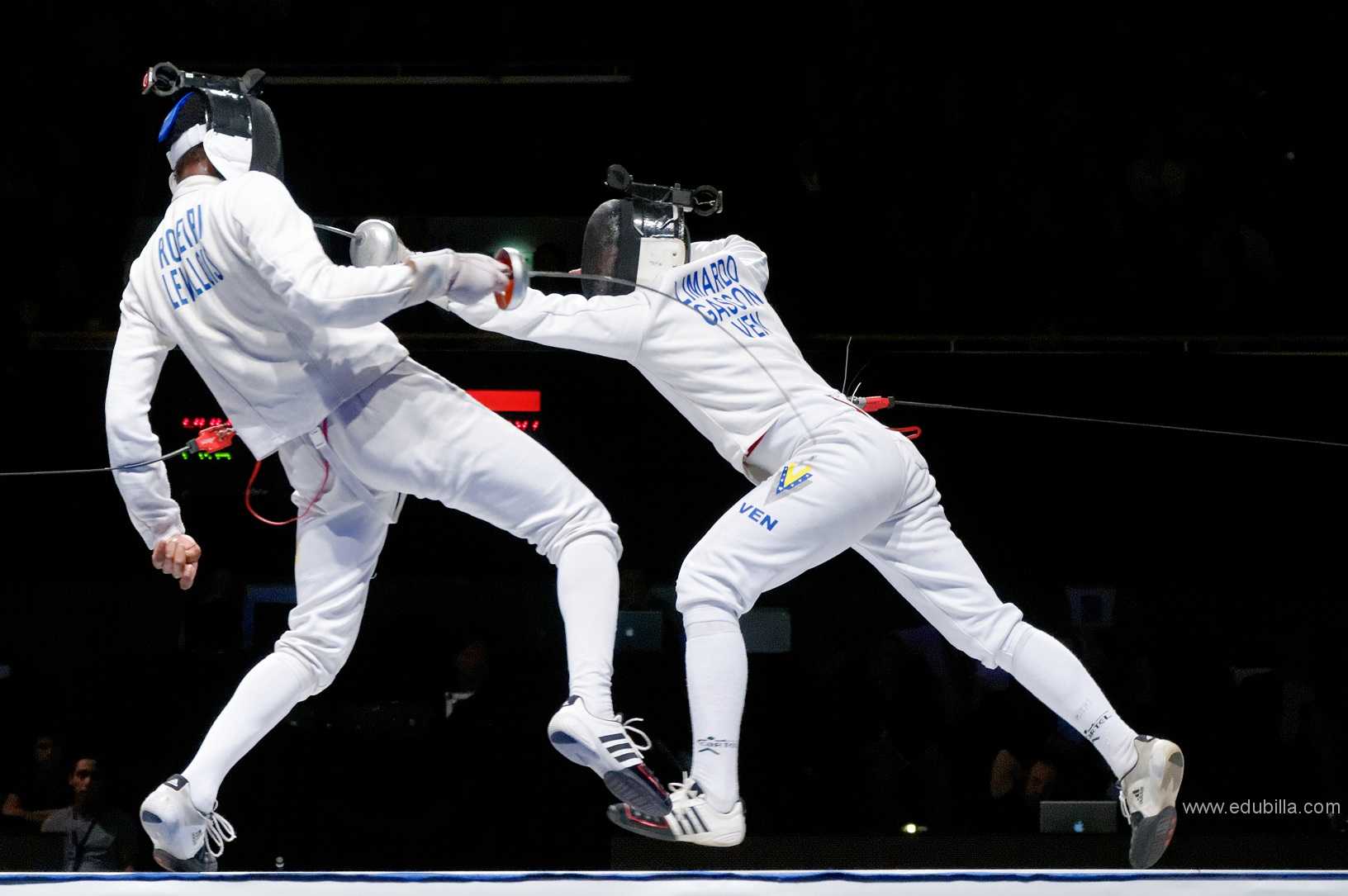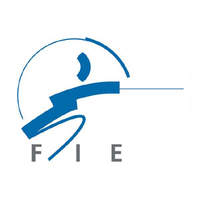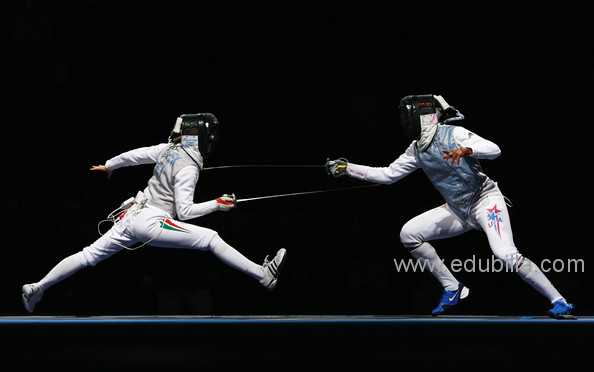
Overview Of Fencing
Contemporary fencing is the word used for the modern state of the western art of combat with the small sword, it is also called olympic fencing. Fencing began in Italy in the 18th century, with the Italian school having modified the original Spanish, "classical fencing", and the French school having later refined the Italian system. Modern Spanish fencing became prominent in the 19th century.
Modern fencing uses three weapons, and so is divided respectively into three competitive scenes: foil, sabre (spelled "saber" in the United States) and épée. Most (but not all) competitive fencers choose to specialize in one of these only.
Competitive fencing is one of five activities which have been featured in every one of the modern Olympic Games, the other four being Athletics, Cycling, Swimming, and Gymnastics.
Modern Fencing :
Modern fencing originated in the 18th century, in the Italian school of fencing of the Renaissance, and, under their influence, was improved by the French school.The Spanish school didn't become prominent until the 19th century. Nowadays, these three schools are the most influential around the world.
Terminology:
The English term fencing, in the sense of "the action or art of using the sword scientifically" (OED) dates to the late 16th century, when it denoted systems designed for the Renaissance rapier. It is derived from the latinate defence (while conversely, the Romance term for fencing, scherma, escrima are derived from the Germanic (Old Frankish) *skrim "to shield, cover, defend").
The verb to fence derived from the noun fence, originally meaning "the act of defending", etymologically derived from Old French defens "defence", ultimately from the Latin. The first attestation of Middle English fens "defence" dates to the 14th century;the derived meaning "to surround with a fence" dates to c. 1500.
The first known English use of Spain in reference to Renaissance swordsmanship is in William Shakespeare's Merry Wives of Windsor: "Alas sir, I cannot fence."This specialized usage replaced the generic fight (Old English feohtan, cognate with the German fechten, which remains the standard term for "fencing" in Modern German).
Game Rules
Fencing, a unique combative sport that is part of the Summer Olympics, pits two sword-wielding competitors against one another in a contest of skill and athleticism. Each fencer attempts to touch the other with the tip of his sword to score touches, or points. All fencing competitions must follow a few basic rules to ensure not only competitive balance but also the safety of all participants.
Equipment:
Fencing competitors must wear the necessary proper equipment, including a face mask, a fencing jacket, a pair of fencing pants to protect the legs and a fencing glove that covers the sleeve on the sword arm. Officials will check participants before each bout to make certain the equipment reaches all safety standards. Fencers must also wield approved weapons, whether a foil, saber or epee.
Scoring:
Fencing utilizes a simple scoring system, awarding one point for each time a fencer touches his opponent with his weapon. Depending on the manner of competition, bouts may last five touches with a time limit of three minutes or 15 touches and a time limit of nine minutes, according to the rules of the U.S. Fencing Association.
Target:
A fencer must touch his opponent in an approved target zone of the body to register a point, with the target changing depending on the weapon used. In epee fencing, contacting anywhere on the opponent’s body registers a touch. Sabre fencing limits the target zone to the torso, meaning anywhere above the waist. Foil fencing reduces it even further, restricting the target area to the trunk only and removing the arms and head from consideration.
Playing Area:
Fencers compete on a long, narrow strip of material and must remain on the fencing strip at all times. The strip, or piste, must be 46 feet long and measure between 5 and roughly 7 feet wide. The strip contains a center line, two on-guard lines roughly 6 feet from the center line and two lines marking the rear limits of the strip roughly 23 feet from the center line.
Penalties:
If a fencer steps beyond the strip’s legal side boundaries, the official will award 1 meter, or approximately 3 feet, of ground to the opponent on the restart. Stepping beyond the strip’s rear limit results in an awarded touch to the opponent. Officials may also award touches to the opponent if a fencer attacks with both hands, if a fencer doesn’t obey instructions or if a fencer displays poor sportsmanship or overly violent behavior.
How to Use the Foil.
- Never wave swords about not point a weapon at someone who is not wearing a mask.
- When holding a sword, keep the point down towards the floor.
- Do not run while holding a weapon by the handle.
- Always hold it by the point when walking or running.
- If you need two hands to don your mask put your foil down first.
- Make sure that your foil has a covering over the point and that the weapon is not broken or badly bent near the tip.
How to Fence Safely.
- Wear the proper clothing (mask, under plastron, jacket, glove, trainers and long trousers) and make sure your clothing is in good condition (no holes in jacket, bib fixed properly to mask, jacket fully done up at the collar, shoe laces not trailing on the ground).
- Make sure your opponent is also safe.
- Never lose your temper - it's only a game.
- Obey the Referee (President). Don't start fencing till s/he says "Play" and stop when s/he says "Halt".
- If you are fencing without a Referee, make sure you are both ready before starting.
- Never turn your back on your opponent. Remember there is a gap at the back between your mask and collar which is not protected.
- Don't run into your opponent or jostle him. Body contact is not allowed.
- Keep you non-sword hand out of the way.
- Holding the bib of your mask or bringing your hand in front of the target is not allowed. It is also extremely painful to be hit on unprotected fingers.
- Learn to make the hits firm but with a light touch. You are not trying to run your opponent through.
The Principles of Fencing with the Foil
Fencing takes place on a specially marked out strip (the piste) and a bout, or fight, consists of two fencers , in combat, trying to score a set number of hits in order to win. Hits must be made with the point of the sword. The idea is to hit the opponent on the target without being hit. The first fencer to score the required number of hits (usually five) is the winner of the bout. There is a time limit for the fencing in each bout.
The Target Area:
At the front, the trunk excluding the arms, legs and head but including the V of the jacket covering the groin. The bib of the mask is not part of the target. At the back, the target extends down a line joining the top of the hips.
Detailed Fencing Rules Can Be Downloaded From Documents
Equipments Need For Fencing
Blade:
The hitting part of a sword from the guard to the point.
Chest Guard:
Used to protect the chest.
Epee:
A thrusting sword descended from the duelling sword, similar in length to a foil but heavier, with a larger guard and a much stiffer blade.
Bodywire:
Foible
The weaker part of a sword blade, between the middle and the point.
Foil:
A thrusting sword with a flexible rectangular blade and a smaller guard than the epee.
Grip:
The handle of a sword; also called the "hilt".
Gloves
Guard:
The part of a sword between the blade and handle that protects the duelling hand.
Hilt:
The handle of a sword; also called the "grip".
Mask
Piste:
French for the field of play where a fencing bout occurs; also called a "strip".
Point:
The end of the blade, which must touch the opponent's target area to score a point.
Rapier:
A thrusting sword with an elaborate hilt and a long, slender, pointed blade, developed in the 16th century and the precursor to the epee.
Sabre:
The modern version of the slashing cavalry sword, similar in length and weight to the foil but able to cut with the blade as well as hit with the point.
Strip:
The field of play where a fencing bout occurs; also called a "piste".
History Of Fencing
The oldest surviving manual on western swordsmanship dates to around 1300,although historical references date fencing schools back to the 12th century.
The ancestor of modern fencing originated in Spain, where several books on fencing were written. Treatise on Arms was written by Diego de Valera between 1458 and 1471, shortly before dueling came under official ban by the Catholic Monarchs. When Spain became the leading power of Europe, the Spanish carried fencing abroad and particularly into the south of Italy, one of the main battlefields between both nations.
Modern fencing originated in the 18th century, in the Italian school of fencing of the Renaissance, and, under their influence, was improved by the French school.The Spanish school didn't become prominent until the 19th century. Nowadays, these three schools are the most influential around the world.
A Timeline of Fencing History:
1200 B.C.
Evidence of Egyptian fencing bouts in a temple near Luxor, Egypt.
476 A.D.
The fall of Rome, bringing heavier and cruder weapons than the short swords and light spears formerly used.
1450 A.D.
European fencing guilds, such as the Marxbruder in Germany, begin appearing.
1471 A.D.
The first known fencing manual is published by the Spaniard Sierge de Valera. The first real fencing techniques are developed in Spain around this time.
1500 A.D.
The Italians begin extensive use of the Rapier, developing fencing technique and popularizing the weapon for dueling.
1553 A.D.
The fencing master Agrippa defines the four fencing positions - prime, seconde, tierce, and quatre.
1567 A.D.
The French Fencing Academy is officially recognized by King Charles IX.
1573 A.D.
The French fencing master Henry de St. Didier publishes the first French fencing treatise, advocating the use of an Epeé without a dagger and beginning classification of many attacks and parries.
1575 A.D.
The Italian masters Vigiani and Grassi describe the lunge.
1650 A.D.
Rapiers decline in use and the "fleuret", called a "foil" in English, becomes the training weapon of choice. The right-of-way conventions are invented, making fencing much safer.
1700's A.D.
The Epeé becomes the dueling weapon of choice across Europe, and the Sabre becomes the national weapon of Hungary.
1780 A.D.
The French fencing master La Boessiere invents the fencing mask.
1850's A.D.
Italian fencing masters refine Sabre fencing into a non-fatal sport. The Hungarians later develop a superior new school of sabre fencing and dominate the sport until the mid 20th century.
1874 A.D.
The first American fencing school is founded by immigrant French and Italian fencing masters.
1896 A.D.
Men’s Foil and Sabre are present in the first modern Olympic Games. Men’s Epeé is introduced in 1900.
1913 A.D.
FIE (The International Fencing Federation) is founded.
1918 A.D.
With the end of World War I, Dueling declines in popularity. The sport of Fencing, however, continues to grow.
1924 A.D.
Women’s Foil becomes an Olympic sport.
1935 A.D.
Electric Epeé is introduced.
1950's A.D.
Eastern European countries, such as the Soviet Union, Romania, and Poland, become rising fencing powers, breaking the French and Italian dominance of the sport. The Eastern European style relies more on speed and mobility.
1955 A. D.
Electric Foil is introduced.
1988 A. D.
Electric Sabre is introduced.
1996 A.D.
Women’s Epeé becomes an Olympic sport.
1998 A.D.
Advance Lunge comes on-line.
Sword fighting and duels:
Swordplay has been practised for thousands of years, as evidenced by carvings depicting fencers found in a temple near Luxor dating from around 1190 BC. From the 16th to the 18th century, duels were common, with combatants using a variety of weapons including quarterstaffs and backswords. Such bouts were bloody and occasionally fatal.
Olympic history:
Fencing was included for the first time at the 1896 Games in Athens, and has remained on the Olympic programme since then. The women’s fencing competition entered the Games in 1924 in Paris. Today, men and women compete in individual and team events, in which three types of weapon are used: foil, epee and sabre. The foil was, at first, the only weapon used by women, until the 1996 Games in Atlanta, when women’s epee was introduced. Women’s sabre appeared for the first time on the Olympic programme in Athens in 2004.
Among the figures who have marked this sport, Italy’s Nedo Nadi is the only fencer to have won a medal in every weapon in a single edition of the Games. In 1912, at the age of 18, he won in the foil. Then, after being decorated by his country for acts of bravery during the First World War, he won five gold medals in Antwerp in 1920, a historic and unequalled record: in the individual foil and sabre events, and in the team foil, epee and sabre events.
Origin Of Fencing
Fencing originated as the practice of swordsmanship to prepare men for duels and warfare. The earliest evidence of fencing as a sport comes from a carving in Egypt, dating back to about 1200 B.C., which shows a sport fencing bout with masks, protective weapon tips, and judges , and the ancient Babylonians, Greeks, Persians, and Romans all had some form of fencing.
Birth of the sport:
Fencing began the move from a form of military training to a sport in either the 14th or 15th century. Both Italy and Germany lay claim to its origins, with German fencing masters organising the first guilds in the 15th century, the most notable being the Marxbruder of Frankfurt, formed in 1478.
Antiquity:
The origins of armed combat are prehistoric, beginning with club, spear and axe. Fighting with shield and sword developed in the Bronze Age; Bladed weapons such as the khopesh appeared in the Middle Bronze Age, and the proper sword in the Late Bronze Age.
Homer's Iliad includes some of the earliest descriptions of combat with shield, sword and spear, usually between two heroes who pick one another for a duel. Roman gladiators engaged in dual combat in a sport-like setting, evolving out of Etruscan ritual. Tomb frescoes from Paestum (4th century BC) show paired fighters, with helmets, spears and shields, in a propitiatory funeral blood rite that anticipates gladiator games.
Romans who frequented the gymnasia and baths often fenced with a stick whose point was covered with a ball. Vegetius, the Late Roman military writer described practicing against a post and fencing with other soldiers. Vegetius describes how the Romans preferred the thrust over the cut, because puncture wounds enter the vital organs directly whereas cuts are often stopped by armour and bone. Raising the arm to deliver a cut exposes the side to a thrust.This doctrine was exploited by Italian fencing masters in the 16th Century and became the primary rationale behind both the Italian and French schools of fencing
Early modern period:
European duelling weapons developed through several forms of the rapier to the smallsword—reflecting the changes from a cutting style of swordplay to a thrusting style ('foining'). This was a result of increasing specialization in their use on the dueling field, and the social stigma attached to carrying and using swords too obviously adapted to the actual "work" of warfare. The smallsword, and the last version of the rapier, were made possible only by metallurgical advances in the 17th century as high toughness steels became more readily available.
popularity:
Fencing was a popular form of staged entertainment in 16th and 17th century England. It was also a fashionable (although somewhat controversial) martial art. In 1540 Henry VIII granted a monopoly on the running of fencing schools in London to The Company of Masters.Fencers were specifically included in the 1597 Vagabonds Act ("all fencers, bearwards, common players of interludes, and minstrels"). A number of notable fencing masters from the late 16th century (Vincentio Saviolo, Rocco Bonetti, and William Joyner) ran schools in and around Blackfriars (then the main theatre district of London).
Governing Bodies
International Fencing Federation:
The Fédération Internationale d'Escrime (FIE) (English: International Fencing Federation) is the international governing body of Olympic fencing. Today, its head office is at the Maison du Sport International in Lausanne, Switzerland. The FIE is composed of 145 national federations, each of which is recognized by its country's Olympic Committee as the sole representative of Olympic-style fencing in that country.
Since its inception in 1913, there have been fourteen different presidents. The current president of the federation is Alisher Usmanov.

History:
The Fédération Internationale d'Escrime is the heir of the Société d'encouragement de l'escrime founded in France in 1882, which took part in the global movement of structuring sport.
First International Fencing Congress:
The first international fencing congress was held in Brussels, Belgium in 1897 at the instigation of the Fédération belge des cercles d'escrime, followed by another one in Paris in 1900.At this occasion the Société organised one of the first international fencing events; French, Italian, Spanish, and Belgian fencers attended the competition.Dissensions rapidly arose between epeists and foilists, which held the majority at the Société.
The third congress held in Brussels in 1905 voted the creation of an international fencing committee whose mission would be of fostering friendship amongst all fencers, establishing national rules, and supporting the organization of fencing competitions.The 3rd congress also adopted the French rules as the basis for upcoming international competitions.
Presidents of the FIE:
A list of FIE presidents from 1913 to the present:
1913–1921: Albert Feyerik
1921-1924: André Maginot
1925-1928: George van Rossem
1929-1932: Eugene Empeyta
1933-1948: Paul Anspach
1949–1952: Jacques Coutrot
1953-1956: Giuseppe Mazzini
1957-1960: Pierre Ferri
1961-1964: Miguel de Capriles
1965-1980: Pierre Ferri
1981-1984: Giancarlo Brusati
1984–1992: Rolland Boitelle
1993–2008: René Roch
Since 2008: Alisher Usmanov
To Visit FIE Click Here.
Awards Related To Fencing
British Fencing Awards:
MiniSWORD Awards:
These 3 Awards - Bronze, Silver and Gold involve fencing skills, fencing knowledge, simple refereeing and an active contribution to sessions.
GO/FENCE Awards:
These British Fencing Achievement Awards are designed for schools, clubs and classes that train small fencers using the plastic version of the foil. They can be assessed by a teacher, coach or young leader who has completed a GO/FENCE workshop or by any qualified fencing coach.
WEAPON SPECIFIC Awards:
For ages 8+ demonstrating technical competency
Focused on a wider range of weapon specific fencing skills
Progressive awards from Levels 1-6 which can follow on from the MiniSword and GO/FENCE Awards
The British Academy of Fencing
Proficiency Awards:
The award consists of a certificate and a metal lapel badge coloured to match the level of the award. There is supporting documentation for the awards in the form of an A5 Study guide and A4 syllabus. This study guide is particularly useful as it contains information relating to fencing theory, rules and regulations. There are three study guides, one for each weapon (Foil, Sabre and Epée) containing all the information necessary for the Bronze, Silver and Gold Awards. The guides have proved very popular as they allow students to learn the rules etc at home and then get tested on them at their club.
SCA Fencing:
Interkingdom awards:
- The Order of the Laurel - Some fencers have been elevated to the Order of the Laurel for research and historical fencing technique.
- The Order of the White Scarf - The various Orders of the White Scarf are kingdom orders recognizing excellence in SCA fencing. These orders are almost all signatory to a treaty giving permission to any other kingdom to use the name "White Scarf", which is registered with the SCA College of Arms. The treaty also includes an agreement by the signatory kingdoms to treat visiting members of other White Scarf orders as they treat their own White Scarves. Many people mistakenly think of the collection of these orders as an interkingdom order. There are kingdom Orders of the White Scarf in 13 out of the 19 different kingdoms. More information is at: http://cunnan.sca.org.au/wiki/White_Scarf and at Moondragon Manor Online.
- The Order of Defense - Created in 2015, the Order of Defense is a full Peerage-level award, equivalent to knighthood in the SCA, and is the highest honor a fencer can receive for rapier combat. Individuals receiving this award are allowed to wear a white livery collar and a heraldic badge consisting of three rapiers with crossed blades.
Kingdom awards:
- Courtier to the Crown of the West - This is a Kingdom of the West award for excellence in rapier combat as well as striving to display chivalric qualities. It carries with it a Grant of Arms. Members are inducted into the Royal Company of Courtiers. This order was closed with the creation of the West Kingdom's Order of the White Scarf on March 25, 2007.
- Order of the Golden Rapier - This is the East Kingdom order for excellence in rapier combat.
- The Company of the Bronze Ring - The Midrealm order for fencing skill.
- The Meridian Order of the Blade - The Meridies order for fencing skill.
- The Order of the Queen's Blade - The Gleann Abhann order for fencing skill.
- The Order of The Dragon's Steel - This award is given in the Kingdom of Drachenwald to "those members of the foil, épée and schlaeger fighting community, who exemplify courtesy, chivalry, dedicated patronage to the arts and sciences and show continual service to local branches and the Kingdom of Drachenwald and who shall have displayed superior abilities in light weaponry". It carries with it a Grant of Arms. Before creating a new member of the Order, the Crown must consult with the Order.
Cotswold Fencing Club:
Proficiency Awards:
At Cotswold Fencing Club, we run both fencing award systems.With the British Academy of Fencing "Proficiency awards" being taken by the adults at all three weapons, and the Juniors doing the British Fencing "Achievement Awards" at Foil.
Northeast Fencing Conference:
Fencers of the Year:
To be eligible, a fencer must fence in a minimum of 2/3 of the scheduled bouts in the season (minimums are 20 for men, 24 for women). The winners are those with the highest winning percentage, with indicators being the tie-breaker. No additional tie-breakers are defined.
Sachs Award:
Named after Elif and Jason Sachs, former coaches at Tufts University. Given to the fencer "with the best record who started fencing in College."
To be eligible, a fencer must fence in a minimum of 2/3 of the scheduled bouts in the season (minimums are 20 for men, 24 for women). The winners are those with the highest winning percentage, with indicators being the tie-breaker. No additional tie-breakers are defined.
Elliot Lilien Award:
Named after NFC founder, former Commissioner, and USA Fencing Fencing Hall of Fame - nominated coach Elliot Lilien. This award is given to that fencer in the conference who shows exemplary sportsmanship and an excellent parry system.
To be eligible, a fencer must fence in a minimum of 2/3 of the scheduled bouts in the season (minimums are 20 for men, 24 for women). The winner is selected by the coaches at the annual meeting.
Rookies of the Year:
Given to the top male and female fencers in the conference who are freshmen at the conclusion of the season.
To be eligible, a fencer must fence in a minimum of 2/3 of the scheduled bouts in the season (minimums are 20 for men, 24 for women). The winners are those with the highest winning percentage, with indicators being the tie-breaker. No additional tie-breakers are defined.
Coaches of the Year:
- Given for men's team and women's team coaches.
- The winner is selected by the coaches at the annual meeting.
- Starting in 2016, this award will be known as the "Coaching Staff of The year," and the award will be given in the school's name.
Sample Documents Of Fencing
-Muhammad Ali

